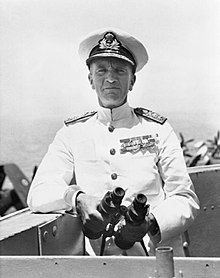William Tennant (Royal Navy officer)
| Sir William George Tennant | |
|---|---|

Vice Admiral Tennant visiting HMS Colossus, May 1945
|
|
| Nickname(s) | "Dunkirk Joe" |
| Born |
2 January 1890 Upton-upon-Severn, Worcestershire, England |
| Died | 26 July 1963 (aged 73) Worcester, Worcestershire, England |
| Allegiance |
|
| Service/branch |
|
| Years of service | 1905–1949 |
| Rank | Admiral |
| Unit | Force Z |
| Commands held |
HMS Repulse America and West Indies Station |
| Battles/wars | |
| Awards |
Knight Commander of the Order of the Bath Commander of the Order of the British Empire Member of the Royal Victorian Order Legion of Merit (United States) |
| Other work | Lord Lieutenant of Worcestershire |
Admiral Sir William George "Bill" Tennant KCB CBE MVO DL (2 January 1890 – 26 July 1963) was a British naval officer. He was lauded for overseeing the successful evacuation of Dunkirk in 1940. Tennant subsequently served as captain of the battlecruiser HMS Repulse, when it searched for German capital ships in the Atlantic. He remained in this capacity when the Repulse was sunk by the Japanese along with HMS Prince of Wales in the South China Sea on 10 December 1941, three days after the attack on Pearl Harbor. He later aided in the setup of the Mulberry harbours and the Pluto pipelines, a crucial part of the success of Operation Overlord.
Born in Upton-upon-Severn and educated at nearby Hanley Castle Grammar School, Tennant joined the Royal Navy at age 15 in 1905, serving onboard HMS Britannia, eventually specialising in navigation in 1913. He later served in the First World War during the Gallipoli campaign and survived the sinking of his ship, the cruiser HMS Nottingham during the Action of 19 August 1916. After the war, Tennant transferred from the cruiser HMS Concord to the new battlecruiser HMS Renown and his future command, HMS Repulse, during the future King Edward VIII's royal tours in the 1920s. By 1932, Tennant had achieved the rank of Captain.
...
Wikipedia
